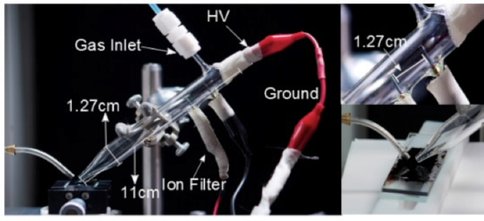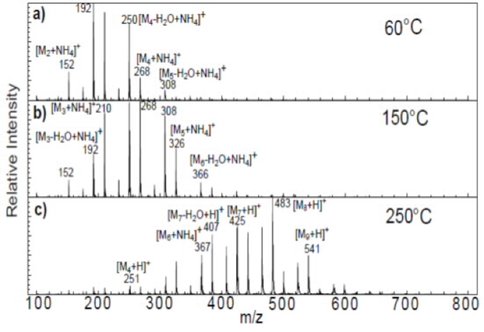2014 Annual Science Report
 NASA Jet Propulsion Laboratory - Titan
Reporting | SEP 2013 – DEC 2014
NASA Jet Propulsion Laboratory - Titan
Reporting | SEP 2013 – DEC 2014
Development of Direct Sampling Methodology for Analysis of Complex Organic Mixtures on Titan’s Surface
Project Summary
Photochemistry in Titan’s dense atmosphere generates a complex mixture of organic molecules that have been deposited on Titan’s surface over time. Requiring no sample pretreatment or handling, the technique of direct analysis in real time (DART), combined with an ion trap mass spectrometer having MS/MS capability, is shown to be an enabling experimental methodology to vaporize, ionize, and structurally characterize organic components of this mixture. A key important development is the use of temperature programmed desorption, accomplished by heating of the probe gas, to examine complex mixtures of organics with a wide range of volatility (polypropylene glycol and tar samples from a petroleum seep). Of particular relevance to astrobiology, this methodology is employed to compare Titan simulants produced in a pulsed discharge from gas mixtures designed to probe mechanistic pathways leading to high molecular weight products.
Project Progress
The field of ambient mass spectrometry has developed rapidly over the past decade. The ability to rapidly perform chemical analysis with minimal sample handling and preparation is key to the success of many ambient ionization sources, with small size and versatility in sampling a wide variety of organics with varying molecular properties being two desired features. The two most widely applied ambient sources are desorption electrospray ionization (DESI) and its variants, and direct analysis in real time (DART). We have developed a compact DART source (mini-DART), shown in Figure 1, that has proven to be extremely successful in analyzing complex organic mixtures. In this work we utilize the mini-DART ionization source for the analysis of complex organic mixtures with the goal of showcasing the abilities of this newly designed source and its multiple applications. These analyses include the characterization of Titan organic stimulants produced by Ames’ Cosmic Simulation Chamber (COSmIC) with various gas mixtures representative of Titan’s atmosphere. To demonstrate sampling of a mixture with wide ranging volatility, polypropylene glycol, the mini-DART gas temperature is systematically increased to observe higher molecular weight components in the sample (Figure 2). This methodology is also applied to the analysis of hydrocarbons, with La Brea Tar Pits Asphalt acting as a representative sample. Again, increase in gas temperature results in detection of increasingly higher molecular weight components, indicating that thermal analysis can provide greater insight into the composition of complex samples.
-
PROJECT INVESTIGATORS:
-
PROJECT MEMBERS:
Jesse Beauchamp
Project Investigator
Kathleen Upton
Co-Investigator
Ella Sciamma-O’Brien
Collaborator
-
RELATED OBJECTIVES:
Objective 1.1
Formation and evolution of habitable planets.
Objective 2.2
Outer Solar System exploration
Objective 3.1
Sources of prebiotic materials and catalysts
Objective 3.2
Origins and evolution of functional biomolecules

